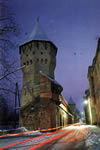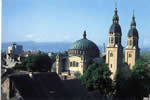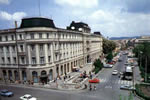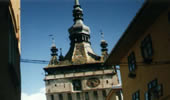
|
Medieval cities in Romania
 Sibiu
- Hermannstadt Sibiu
- Hermannstadt
 Brasov
- Kronstadt
Brasov
- Kronstadt
 Timisoara - Temeschwar
Timisoara - Temeschwar
 Sighisoara
Sighisoara
 Cluj-Napoca -
Klaussenburg
Cluj-Napoca -
Klaussenburg
 Deva
Deva
 Sebes - Muhlbach
Sebes - Muhlbach
 Fagaras
Fagaras

 Sibiu - Hermannstadt, the former name Sibiu - Hermannstadt, the former name
   
 The
City of Sibiu The
City of Sibiu
Along with Cluj-Napoca,Timisoara and Arad,the city of Sibiu is one
of the most beautiful cities in Transylvania.
The city has a special charm because it is a "museum city" which reminds
us of the old times by the walls of its defence tower and the fortifications
of the former Sibiu fortress.The city preserves many old houses and building,real
of the medieval archtecture.
Sibiu is situated at an altitude of 425 - 450 meters, on the banks of
the Cibin river, in a valley that has the Cindrel Mountains in south and
the edge of the Transylvania Plateau in north.Its climate is moderate,
with average annual temperatures of 9 0 C
( - 3 0 in January and 19 0 in July ).
"The
old city",situated in center,is surrownded by the walls of the old fortress.By
tradition , Sibiu is divided in two : the up town and the down town.
Sibiu is known an important touristic center with many and varied objectives.Also,
his neighborhood are picturesqueness and with many atractive places.
Touristic objectives
in Sibiu :
- Piata Mare - " Ringul cel mare" as he was once called,was
the meeting place,the festivals place.
Picturesqueness
festivities took place here with the occasion of a crowning.Copious
meal : oxes, rams, lambs, were roasted to the fires in the big square
and the win couldn't have missed.
The handicrafts- man and their apprentices were presenting national
dances carrying profound meanings.
The 14 february day of 1582 year remained memorable.This was the perfect
place to debate the defence questions.Beheadings, hunggins and even
stick burnings made sensation here until the end of XVIII -th century.
- Turnul Sfatului (
The Council Tower) - situated between Piatza Mare(The Big Square) and
Piatza Mica
( The Small Square).The construction was finished in 1588.He is prierced
by two arches who cut the road to the down town.The tower history has
his dramatica moments.He brokedown in 1586 burying under his slabs the
painter Iohan David who was trying to adorn his arches.To his rebuilding,
he was added with 4 little towers.The actual aspect was given to him
at the restoration in 1824.
- Brukental Museum - construction which plan was projected
by an Austrian architect around 1781 - 1785 in a baroque style.The portal
in massive rock has above the front door Samuel Brukental' s escutcheon.
The museum was for the first time opened for the public in 1817.The
art gallery includes sculptures, graphic arts, XV - XIX th century pictures
made by : Nicolae Grigorescu ( "Gipsy woman head"),Stefan
Luchian ( " Carnations"), Nicolae Tonitza("Portrait of
a girl"),Theodor Aman, Ion Andreeescu,Thedor Pallady,Iosif Iser
- Evangelic Church - built
on ruins of a Roman basilic to the middle of XIVth century and finished
in 1520.In XVth century it suffered a lot of changes:two verandas were
made , the belfry-very modest until that date - was raised up with two
floor more,and then the tower with the access stairs to the belfry and
the galleries where the Renaissance style has made known its presance
were added.
- Catholic
Church (Big
Square)- built in a baroque style between 1726 1728 by the catholic
monks.Having the shape of a church-the interior has a large vault sustained
by strong columns.
- Orthodox
Metropolitan Church ( 35 Mitropoliei Street) -
who's
construction lasted
between 1902-1906.Its arhitecture presents Byzantine characters who
resemble those in St. Sophia Church (Constantinopole).
- Stairs Passage
- recently
arranged.Built in XIIIth century , this passage is also called "Zidul
cu ace":the most picturesqueness place in Sibiu.
- Fortress fortifications and the defence towers (Cetatii
Street)- The
fortifications were raised up in XIVth century , consoldated in XVIIth
century and restaured in 1963".Arquebusier's tower" become
later "Pantatzilor Tower" was built in XVth century on an
octogonal foundation.
 Brasov - Kronstadt , the former name Brasov - Kronstadt , the former name
 The
City of Brasov The
City of Brasov
Although the holiday season has
already begun at the seaside,I' ve met lots of tourists,willing to go
hiking along the well known mountain tracks.In Brasov,during week ends,everybody
naturally goes to Poiana Brasov.Of course,for everyone visiting the City
under Tampa, The Black Churh, The Council Tower and the "Cerbul Carpatin"
restaurant are a must.
Local administration has its eyes and ears set on rebuilding all the necessary
infrastructure that can hopefully assist the mountain loving camper to
easily select the route along which he wishes to go mountaineering.The
tracks leading to and from Poiana Brasov are fortunately very well marked.Most
of the tourists use the cable transport to get up to the "Cristianul Mare"
a first class mountain cabin,at 1704 m altitude,an only 20 minutes walk
away from the "Postavarul" Cabin (1640 m).In Poiana you'll of course find
most of the people walking,
having picnic lunches or sunbathing.The route leading to Brasov is covered in asphalt,with
breath taking curves and fantastic views of the valley.
Brasov ( 324.000 habitants),considered the heart-town of Romania,
is an important economic, touristic, cultural and sportive center of the
country.Brasov is 171km far away from Bucharest.The most usual ways to
Brasov are the road through Prahova Valley and the railway who goes in
parallels with the road.Situated at 592m,on the interior side of the curvature
of carpathian chain, to the foot of Tampa Mountain(960m), Brasov is situated
in the middle of depression.Its climate is moderate, with average annual
temperature of 9 0 (- 5 0 in January and 19 0 in August).
 Historic
dates - on the actual teritory
of the city, a big number of settlements in the neolithic age and the
bronze age was descovered.In the iron age, the Dacians had stable establishments
on the vallies where the actual districts of the city are situated. Brasov
was for the first time certified in the Middle Age, in a document in 1521,
under the name of Brassovia.Become a free town with commercial rights,
Brasov will become in a very short time a city with a prosperous commercial
situation, having intense relations with Moldavia and Wallachia.Brasov
is situated on one of the oldest commercial roads, this was the meeting
place of Wallachia, Moldavia and Transylvania.At the end of XVIth century,Brasov
had started to raise up a fortress,but its fortifications were not ready
when first Turkish invasion in Transylvania took place(1421) and the city
was conquered.Turkish invasion restarted in 1434, but they cannot conquer
the city, beeing surrounded by hard fortifications.Under the walls protection,
Brasov become more and more prosperous. Historic
dates - on the actual teritory
of the city, a big number of settlements in the neolithic age and the
bronze age was descovered.In the iron age, the Dacians had stable establishments
on the vallies where the actual districts of the city are situated. Brasov
was for the first time certified in the Middle Age, in a document in 1521,
under the name of Brassovia.Become a free town with commercial rights,
Brasov will become in a very short time a city with a prosperous commercial
situation, having intense relations with Moldavia and Wallachia.Brasov
is situated on one of the oldest commercial roads, this was the meeting
place of Wallachia, Moldavia and Transylvania.At the end of XVIth century,Brasov
had started to raise up a fortress,but its fortifications were not ready
when first Turkish invasion in Transylvania took place(1421) and the city
was conquered.Turkish invasion restarted in 1434, but they cannot conquer
the city, beeing surrounded by hard fortifications.Under the walls protection,
Brasov become more and more prosperous.
Local
stations radio:Radio Brasov(87,8 FM) and Radio Contact.
Local daily paper:"Transilvania Expres", " Jurnalul de
Brasov", "Gazeta de Transilvania", "Buna ziua, Brasov".
Touristic objectives in Brasov :
- Brasov fortress
-
erected between XIVth and XVIIIth centuries; known as one of the most
strong fortress in Transylvania.It's the keeper of a big number of vestiges:Poarta
Ecaterinei,Poarta Ecaterinei, Bastionul Postavarilor, Bastionul Tzesatorilor,
Bastionul Fierarilor.
The White Tower and the Black Tower are two fortifications exterior
to the fortess who were kept in a very good condition.
- Black
Church - XVIth century - it has been qualified by the speialists
beeing the most representativ monument of the gottic art of our country.This
church is the owner of an organ with 4000 tubes, of an famous organist
in the hall world-Stas Ekhardt-and of a famous colection of oriental
carpets.It was named Black Church by the spots of soot remained on the
walls from the big fire in 1689.Imposing
building, 89m long, 21m high and 38m wide,with an interior tower built
afterwards (65m high).Black
Church is a Catholic church.
- Piatza Sfatului( Council Square) - an
old place for bargain, is dominated bt the old building of the council
(XV th century),with a tower to controle the access to town.The foundation
and the ground floor of the tower, who are still conserved, prove that
this monument was raised up in 1528.Once it used to be the center of
the Townhall.To the ground floor of the tower, we can find the History
Museum where are exposed objects from neolithic and paleolithic age.
- Bartholome Church ( XIIIth - XIVth century ) - very
imposing with strong fortifications consolidated with contreforts .It's
a gottic style construction.
- Catholic - Roman Church ( 21 Muresenilor Street) - built
on the place of an old basilic between 1776 - 1782.It's an illustrative
monument in baroque style with stained -glass windows.
- Art Museum ( 21 Eroilor Bld.) - the
owner of some very valuable pictures of great painters :Nicolae Grigorescu,I.Andreescu,
Stefan Luchian,Nicolae Tonitza.
- Casa Negustorilor numita si Casa Hirscher( The merchant's
house) - built
in 1545 by the model of the ancient market halls in West Europe.This
house is in present "Cerbul Carpatin" restaurant.
- The First Romanian
School Museum
- Dramatic Theatre ( Eroilor Bd)
- Ethnography Museum (23 Eroilor Bd).Open : 9 - 17.00 / Monday
closed
- Sfantul Nicolae Church ( sec XVI- XVIII)
- Sti Petru and Pavel Church ( sec XVIII)
- Sfanta Treime Church( sec XVII - XIX )
- Adormirea Maicii Domnului Church ( Dealul Melcilor).
 Timisoara - Temeschwar
,the former name Timisoara - Temeschwar
,the former name
 Timisoara - flowers town
Timisoara - flowers town
The town on the Bega river, flowers town,Timisoara is called
proudly by the people,the small Viena.Timisoara is the transit town -
the gate to the west frontiers of Romania - offering to the traveller
a stop nice and educative.
Touristic objectives in Timisoara :
- Hunianzilor
Castle - situated in the center of the
town, who hide in present Banatului Museum( built in XIV th century
by Iancu de Hunedoara ); right in front of the castle was installed
the first street lamp who had annonced the Europe that Timisoara was
the first town with electric public lightning.
- Catholic
Dome - situated in Union Square(Piata Unirii).Built in 1774 in
baroque style, it has nine altars painted by Viennese specialists.The
Dome with its perfect acoustics, it's an atraction for many music fans
passioned by the organ concerts.In the front of the Dome, there is a
fountain with healing waters
- Rasciana Cathedral
- built in XVIIIth century, has been since 1964 an historic monument.The
building, who at the begining of XVIIIth century was only a small church
in wood become later a cathedral of the baroque style(transformation
made by the Serbian community);it's name since 1865 beeing Orthodoxe
-Serbian Cathedral.
 Sighisoara Sighisoara

more pictures
|


